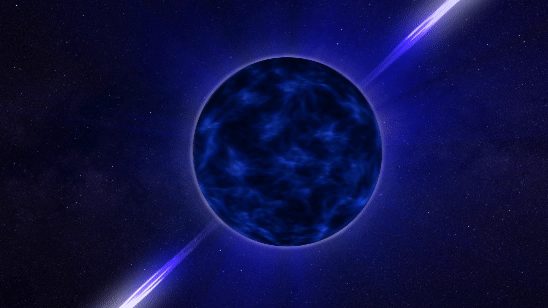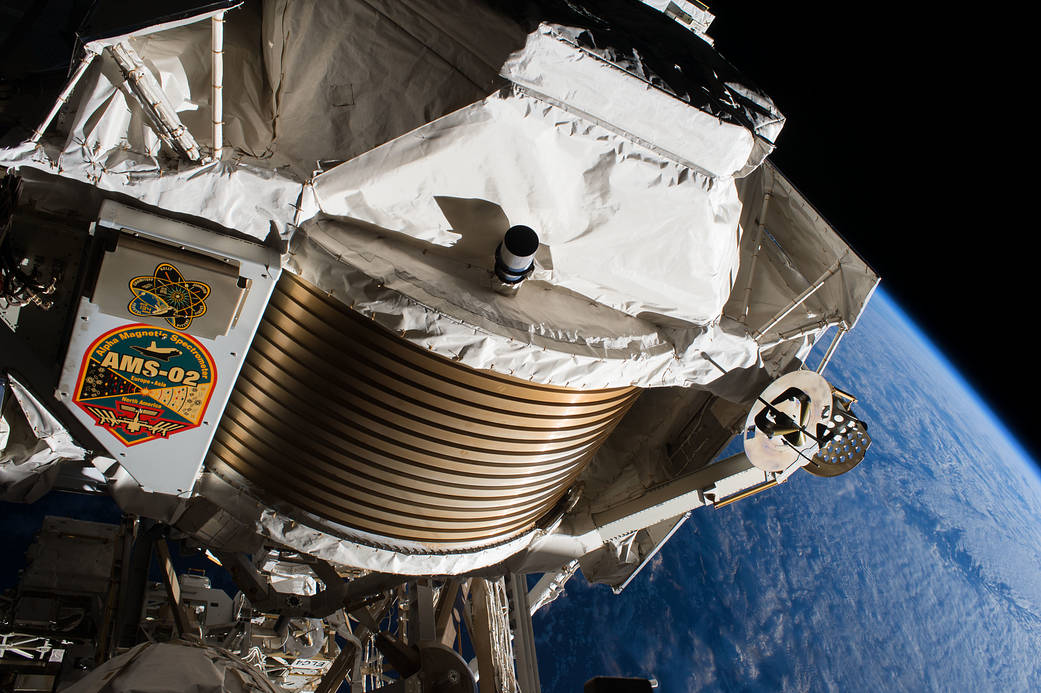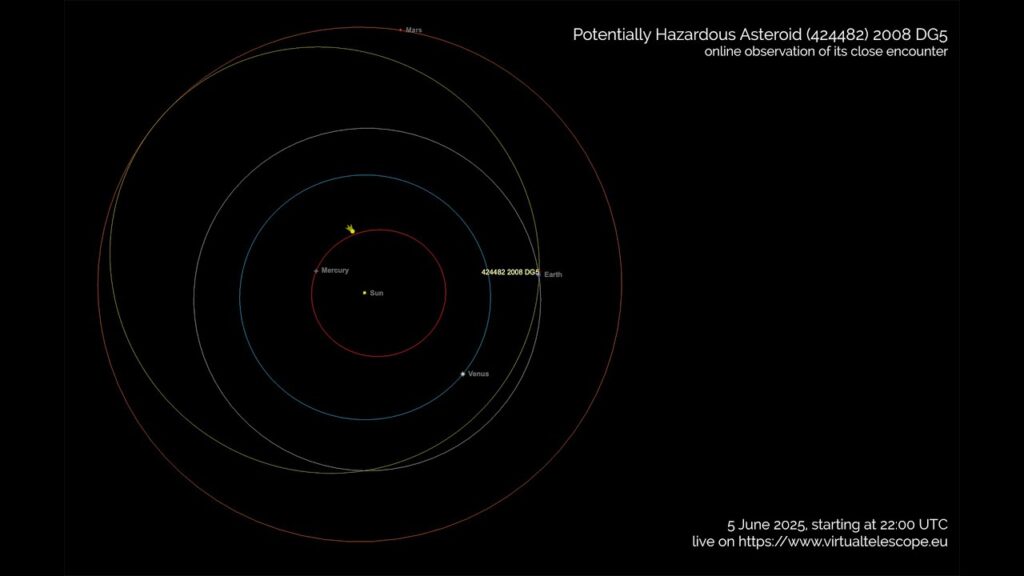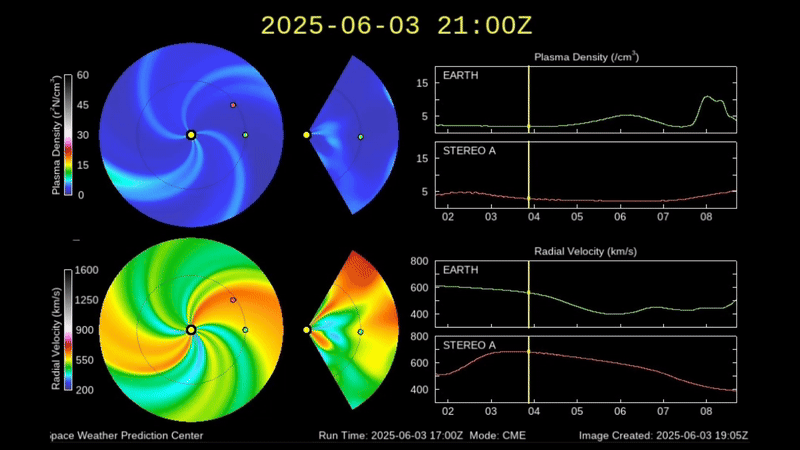Science in Space – February 2024
Instruments on the exterior of the International Space Station provide data on astrophysical phenomena that are helping scientists better understand our universe and its origins. Crew members install and maintain these instruments robotically and scientific teams operate them remotely.
One of the instruments, the Neutron star Interior Composition Explorer (NICER), measures X-rays emitted by neutron stars and other cosmic objects to help answer questions about matter and gravity. Neutron stars, the densest measurable objects in the universe, are the remains of massive stars that exploded into supernovae. Some are called pulsars because they spin, sweeping bright X-ray beams across the sky like lighthouse beacons. NICER is located on the space station because the X-rays emitted by neutron stars do not penetrate Earth’s atmosphere.

In May 2023, NICER developed a “light leak,” with unwanted sunlight entering the instrument. As a result, the team limits daytime observations to objects far from the Sun’s position in the sky and lowers NICER’s sensitivity during the orbital day. Nighttime observations are not affected. Even with these limitations, NICER’s recent observations continue to generate results and papers, many published in top-tier journals.
Neutron Star Cores
Scientists suspect that neutron stars grow denser toward their cores, but the form of matter in their centers remains unknown. NICER’s precise measurements of the size and mass of these stars are providing more insight.
In 2021, two teams used different approaches to model the size of PSR J0740+6620, the heaviest known pulsar at 2.1 times the Sun’s mass, and produced measurements that are essentially in agreement.1,2 This star is almost 50% more massive than a previous pulsar measured by NICER, J0030+0451, but is essentially the same diameter.3,4 Scientists are investigating how this finding might change popular models of neutron star core composition.
X-ray Binaries
NICER has advanced understanding of X-ray binaries, systems where superdense objects such as neutron stars are paired with normal stars. X-ray binaries produce gravitational waves, invisible ripples in space-time also produced by exploding stars and merging black holes. Data from gravitational wave signals are being used to map the galaxy’s binaries.
Joint observations by NICER and NASA’s Nuclear Spectroscopic Telescope Array (NuSTAR) revealed specific properties of an X-Ray binary, 4U 0614+091, that increase understanding of these phenomena.5 A joint NICER and NuSTAR observation of an ultra-compact X-ray binary (UCXB), 4U 1543-624, is helping scientists fine tune models of gravitational waves from these sources.6 The behavior of UCXBs suggests that the superdense object of the pair takes material from its companion star.
Analysis of NICER observations of the gamma-ray binary LS 5039 found its X-ray emissions vary, perhaps because of winds from its companion.7 Gamma-ray binaries include a normal and a collapsed star. This observation helps astronomers study the nature of these stars and some of the most extreme conditions in the universe.
Pulsar Outbursts
Similar behaviors in outbursts from the pulsar PSR J1846-0258 monitored by NICER in 2020 and 2006 suggest there is a continuum of neutron star types.8 At one end of the continuum are rotation-powered pulsars (RPPs), which shine from energy generated by a slowing rotation, and at the other, magnetars, which have magnetic fields up to a thousand times stronger than typical neutron stars.
Astrophysicists also compared NICER data on X-ray outbursts in 2021 and 2006 from RS Ophiuchi.9 This system is a recurrent nova, a binary system with a white dwarf that is taking material from its companion star. This collected material eventually undergoes a thermonuclear explosion, blasting out a mushroom cloud. Scientists used NICER data to probe the chemical content of the cloud and the white dwarf’s hot surface.

More Astrophysics Tools
CALET, an instrument developed by JAXA (Japan Aerospace Exploration Agency), measures the electron spectrum of cosmic rays to search for signatures of dark matter. Data from CALET validated a method for measuring changes in the solar magnetic field, which affects weather and radio communications on Earth.10
JAXA’s Monitor of All-sky X-ray Image (MAXI) investigation scans 95% of the sky for X-ray sources with each orbit of the space station. MAXI has observed hundreds of outbursts, including five between 2016 and 2020 from the X-ray binary Aquila X-1.11 Observing such systems reveals the dynamics of the high-energy processes fueled by the transfer of matter between stars. MAXI also observed, for the first time, a massive black hole swallowing a star in the center of a galaxy 3.9 billion light years away.12

When MAXI detects an object that brightens suddenly, the Orbiting High-energy Monitor Alert Network (OHMAN) alerts NICER so it can observe the object. By directly connecting the two instruments, OHMAN cut the response time from hours or days to minutes and could enable new discoveries about the physics behind some of the most powerful events in the universe.

Crew members traveling to the Moon or Mars need protection from cosmic rays, high energy particles from distant stars. The Alpha Magnetic Spectrometer (AMS-02) detects cosmic ray particles and determines their charge. Among the many papers using AMS-02 data is one reporting distinct differences in duration and strength of daily electron and proton flows in cosmic rays.13 These data help scientists better understand cosmic rays and could help protect astronauts on future missions.
John Love, ISS Research Planning Integration Scientist
Expedition 70
Search this database of scientific experiments to learn more about those mentioned above.
Citations:
1 Miller MC, Lamb FK, Dittmann AJ, Bogdanov S, Arzoumanian Z, Gendreau KC, et al. The Radius of PSR J0740+6620 from NICER and XMM-Newton Data. The Astrophysical Journal Letters. 2021 September; 918(2). DOI: 10.3847/2041-8213/ac089b.
2 Riley TE, Watts AL, Ray PS, Bogdanov S, Guillot S, et al. A NICER View of the Massive Pulsar PSR J0740+6620 Informed by Radio Timing and XMM-Newton Spectroscopy. The Astrophysical Journal Letters. 2021 September. 918(2). DOI: 10.3847/2041-8213/ac0a81
3 Miller MC, Lamb FK, Pittman AJ, Bogdanov S, Arzoumanian Z, et al. PSR J0030+0451 Mass and Radius from NICER Data and Implications for the Properties of Neutron Star Matter. The Astrophysical Journal Letters. 2019 December. 887(1). DOI: 10.3847/2041-8213/ab50c5.
4 Riley TE, Watts AL, Bogdanov S, Ray PS, Ludlam RM, et al. A NICER View of PSR J0030+0451: Millisecond Pulsar Parameter Estimation. The Astrophysical Journal Letters. 2019 December. 887(1). DOI: 10.3847/2041-8213/ab481c.
5 Moutard DL, Ludlam RM, Garcia JA, Altamirano D, Buisson DJ, et al. Simultaneous NICER and NuSTAR observations of the ultracompact X-ray binary 4U 0614+091. The Astrophysical Journal. 2023 November; 957(1): 27. DOI: 10.3847/1538-4357/acf4f3.
6 Ludlam RM, Jaodand AD, Garcia JA, Degenaar N, Tomsick JA, et al. Simultaneous NICER and NuSTAR observations of the ultracompact X-Ray binary 4U 1543–624. The Astrophysical Journal. 2021 April; 911(2): 123. DOI: 10.3847/1538-4357/abedb0.
7 Yoneda H, Bosch-Ramon V, Enoto T, Khangulyan D, Ray PS, et al. Unveiling properties of the nonthermal X-ray production in the gamma-ray binary LS 5039 using the long-term pattern of its fast X-ray variability. The Astrophysical Journal. 2023 May; 948(2): 77. DOI: 10.3847/1538-4357/acc175.
8 Hu C, Kuiper LM, Harding AK, Younes GA, Blumer H, et al. A NICER view on the 2020 magnetar-like outburst of PSR J1846−0258. The Astrophysical Journal. 2023 August; 952(2): 120. DOI 10.3847/1538-4357/acd850.
9 Orio M, Gendreau KC, Giese M, Luna GJ, Magdolen J, et al. The RS Oph outburst of 2021 monitored in X-Rays with NICER. The Astrophysical Journal. 2023 September; 955(1): 37. DOI: 10.3847/1538-4357/ace9bd.
10 Adriani O, Akaike Y, Asano K, Asaoka Y, Berti E, et al, CALET Collaboration. Charge-sign dependent cosmic-ray modulation observed with the Calorimetric Electron Telescope on the International Space Station. Physical Review Letters. 2023 May 25; 130(21): 211001. DOI: 10.1103/PhysRevLett.130.211001.
11 Niwano M, Murata KL, Ito N, Yatsu Y, Kawai N. Optical and X-ray variations during five outbursts of Aql X-1 in 3.6 yr from 2016. Monthly Notices of the Royal Astronomical Society. 2023 November 1; 525(3): 4358-4366. DOI: 10.1093/mnras/stad2561.
12 Burrows DN, Kennea JA, Ghisellini G, Mangano V, Zhang BB, et al. Relativistic jet activity from the tidal disruption of a star by a massive black hole. Nature. 2011 August 25; 476421-424. DOI: 10.1038/nature10374.
13 Aguilar-Benitez M, Ambrosi G, Anderson H, Arruda MF, Attig N, et a;. Temporal structures in positron spectra and charge-sign effects in galactic cosmic rays. Physical Review Letters. 2023 October 13; 131(15): 151002. DOI: 10.1103/PhysRevLett.131.151002.







